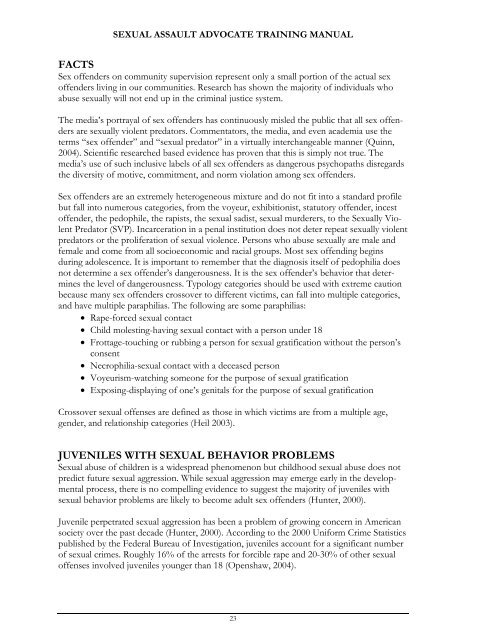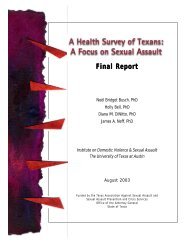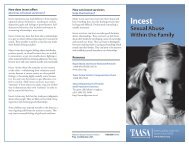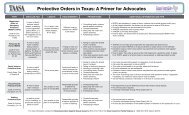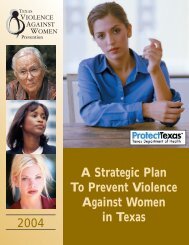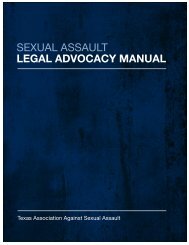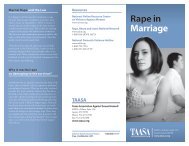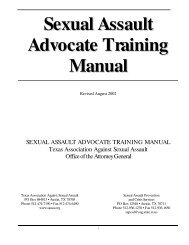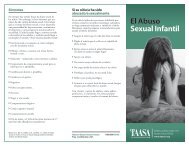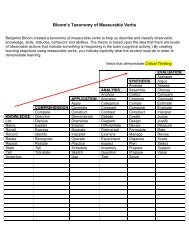Sexual Assault Advocate Training Manual - Texas Association ...
Sexual Assault Advocate Training Manual - Texas Association ...
Sexual Assault Advocate Training Manual - Texas Association ...
Create successful ePaper yourself
Turn your PDF publications into a flip-book with our unique Google optimized e-Paper software.
SEXUAL ASSAULT ADVOCATE TRAINING MANUAL<br />
FACTS<br />
Sex offenders on community supervision represent only a small portion of the actual sex<br />
offenders living in our communities. Research has shown the majority of individuals who<br />
abuse sexually will not end up in the criminal justice system.<br />
The media’s portrayal of sex offenders has continuously misled the public that all sex offenders<br />
are sexually violent predators. Commentators, the media, and even academia use the<br />
terms “sex offender” and “sexual predator” in a virtually interchangeable manner (Quinn,<br />
2004). Scientific researched based evidence has proven that this is simply not true. The<br />
media’s use of such inclusive labels of all sex offenders as dangerous psychopaths disregards<br />
the diversity of motive, commitment, and norm violation among sex offenders.<br />
Sex offenders are an extremely heterogeneous mixture and do not fit into a standard profile<br />
but fall into numerous categories, from the voyeur, exhibitionist, statutory offender, incest<br />
offender, the pedophile, the rapists, the sexual sadist, sexual murderers, to the <strong>Sexual</strong>ly Violent<br />
Predator (SVP). Incarceration in a penal institution does not deter repeat sexually violent<br />
predators or the proliferation of sexual violence. Persons who abuse sexually are male and<br />
female and come from all socioeconomic and racial groups. Most sex offending begins<br />
during adolescence. It is important to remember that the diagnosis itself of pedophilia does<br />
not determine a sex offender’s dangerousness. It is the sex offender’s behavior that determines<br />
the level of dangerousness. Typology categories should be used with extreme caution<br />
because many sex offenders crossover to different victims, can fall into multiple categories,<br />
and have multiple paraphilias. The following are some paraphilias:<br />
• Rape-forced sexual contact<br />
• Child molesting-having sexual contact with a person under 18<br />
• Frottage-touching or rubbing a person for sexual gratification without the person’s<br />
consent<br />
• Necrophilia-sexual contact with a deceased person<br />
• Voyeurism-watching someone for the purpose of sexual gratification<br />
• Exposing-displaying of one’s genitals for the purpose of sexual gratification<br />
Crossover sexual offenses are defined as those in which victims are from a multiple age,<br />
gender, and relationship categories (Heil 2003).<br />
JUVENILES WITH SEXUAL BEHAVIOR PROBLEMS<br />
<strong>Sexual</strong> abuse of children is a widespread phenomenon but childhood sexual abuse does not<br />
predict future sexual aggression. While sexual aggression may emerge early in the developmental<br />
process, there is no compelling evidence to suggest the majority of juveniles with<br />
sexual behavior problems are likely to become adult sex offenders (Hunter, 2000).<br />
Juvenile perpetrated sexual aggression has been a problem of growing concern in American<br />
society over the past decade (Hunter, 2000). According to the 2000 Uniform Crime Statistics<br />
published by the Federal Bureau of Investigation, juveniles account for a significant number<br />
of sexual crimes. Roughly 16% of the arrests for forcible rape and 20-30% of other sexual<br />
offenses involved juveniles younger than 18 (Openshaw, 2004).<br />
23


